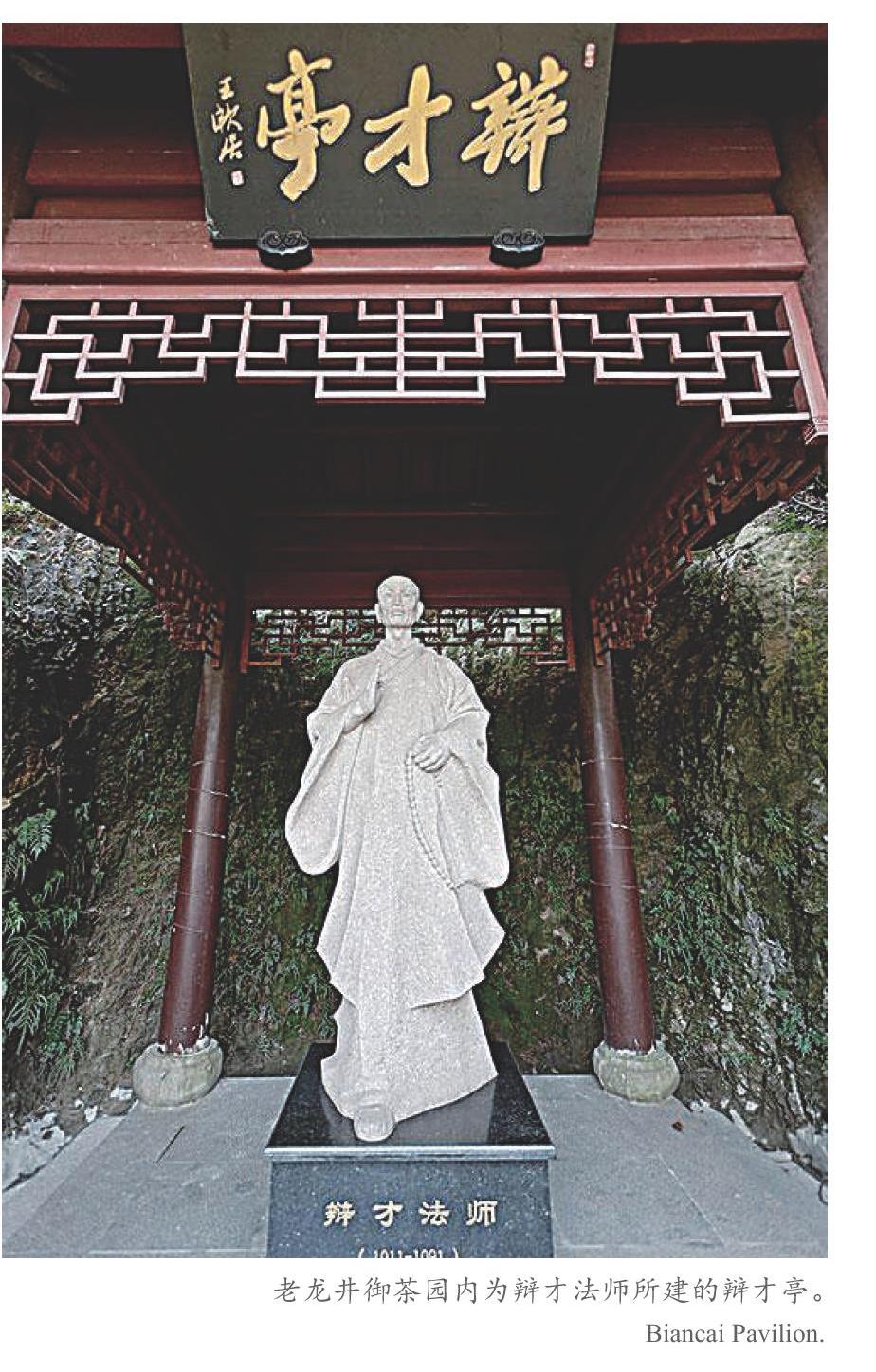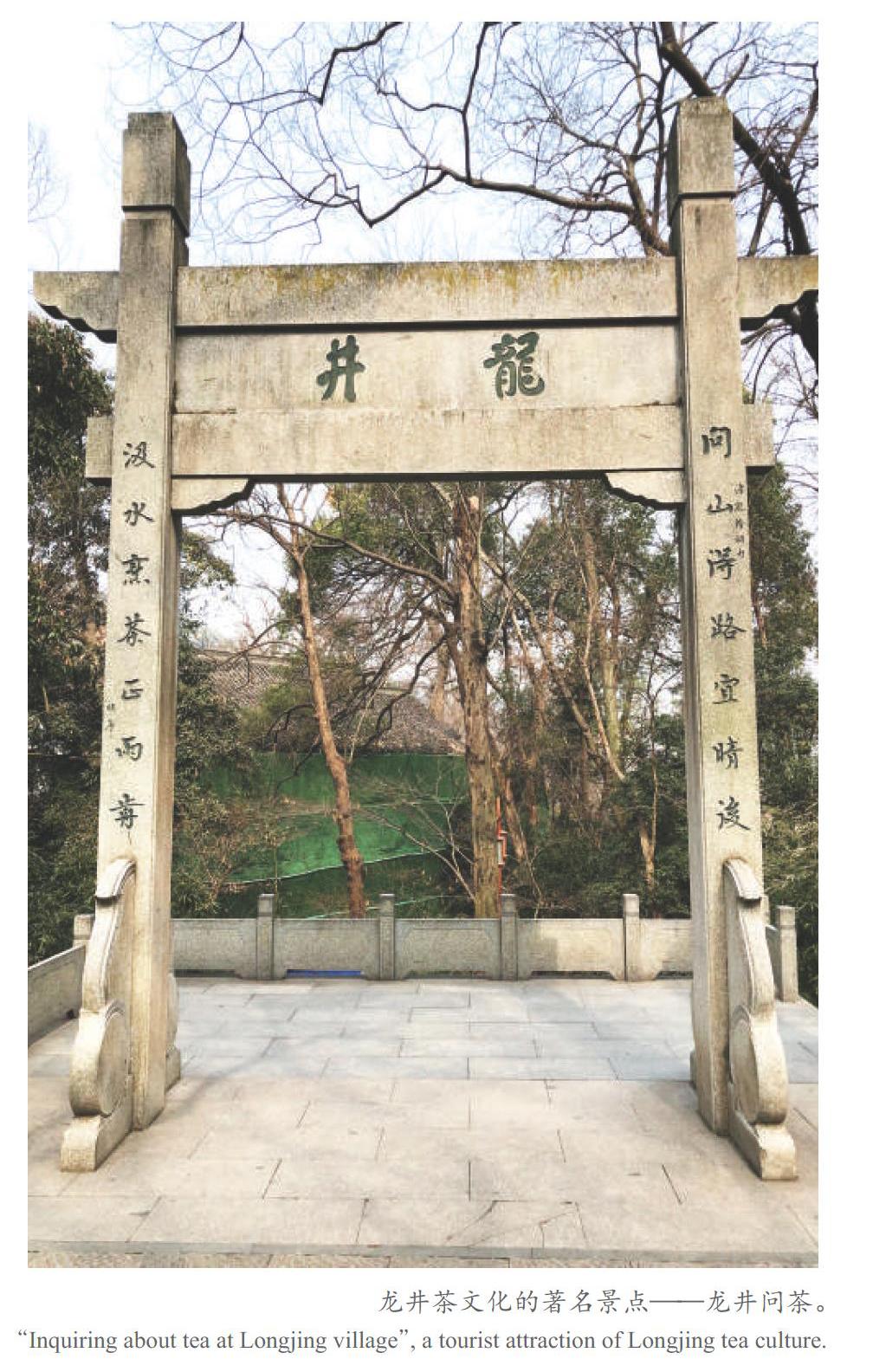辩才与龙井
2021-06-24司马一民
司马一民



现在杭州龙井的出名,是因为龙井茶。
你喝什么?
我喝龙井。
那一个茶字,基本是省略掉了。龙井就是龙井茶的代名词。
其实,近千年前龙井就很出名,那是因为一位高僧和一座寺院,还有那里的山水风光。高僧是辩才,寺院是龙井寺。
辩才不但是一位高僧,而且是一位诗人,他与苏轼、秦观、黄庭坚等结为诗友,有诗唱和。又因为有苏轼等诗人到访龙井寺,还留下许多趣事,使得龙井名声远播。这些留待后文细说,此文单说辩才与龙井和龙井寺。
辩才对龙井的贡献非常大,先来看看他为龙井写的十首“形象推广”诗:
《龙井十题》
狮子峰
独尔群山里,人称狮子峰。
无心自哮吼,显晦烟云中。
风篁岭
风篁荫修岭,挺节含虚心。
悠悠往还客,孰不聆清音。
归隐桥
谢讲竺峰寺,归隐新此桥。
院幽结林表,身老寄烟霄。
寂室
心寂寂自绝,此意焉思说?
寒云散空庭,独有月照雪。
照阁
高峰衔皎月,深壑泻飞湍。
谁来白云里,与汝凭栏看。
呐斋
忆昔毗耶老,杜口有谁听。
还闻寂寂里,其辩过雷霆。
潮音堂
真说无所示,真听无所闻。
海潮山外过,妙响入深云。
萨陲石
巨石如掌平,兀然半青嶂。
钦哉昔道人,饲虎兹岩上。
冲泉
物外老余生,泉发幽岩里。
自可给瓶盂,不羡沧溟水。
龙井亭
虚亭乱石间,中有潜虬府。
澄湛源莫穷,旱岁为霖雨。
插播一小段:现在我们都有这样的经历,因为看了某地的风光片、读了某个故事、知道了哪个名人事迹等,就想去那个场景看看。比如爱尔兰的莫赫悬崖,就因为是电影《哈利波特》的取景地,吸引了无数的游客,其实莫赫悬崖很久以前就在啊,只是电影《哈利波特》的顺便推广,现在变成了特别热门的观光景点。
回过来说龙井,尽管辩才描述的这些地、这些景,经历了千年的变迁之后,有的我们现在已经看不到了,但是在当时大概有不少人是因为读了《龙井十题》而心生向往,便走访龙井。要不然,《龙井十题》也不会流传到今天。因为辩才、因为《龙井十题》、因为龙井寺,引来了苏轼等名流,才给后世留下了许多佳话和传说。
辩才的《龙井十题》虽然是写景,细细品读,却蕴含着禅意,与他出家人的身份十分契合。这就要说说辩才的身世了。
《咸淳临安志》卷七十有条目“元净”:
元凈
本姓徐,字无象,於潜人,生而左肩肉起如袈裟绦,八十一日乃灭,及师之终实八十有一岁。师生十岁出家,二十五赐紫衣及辨才号。知杭州吕溱请师住大悲宝阁居十年,沈文通治杭命住上天竺,乃以教易禅师凿山增室,几至万础,重楼杰阁,冠于浙西学者数倍。其故,诏名其院曰灵感观音,居十七年还於潜。逾年复归天竺清献公赵抃与师为世外友,赞之曰:师去天竺山空鬼哭,天竺师归道场光辉。复留,三年谢去,老于南山龙井之上。与僧熙仲会食,仲视师眉闲有光如荧,遽起揽之,得舍利,自是常有于其卧处得之者,及其将化召常所往来僧道潜告之曰,吾西方业成克期而逝。门下侍郎苏辙撰碑,翰林学士苏轼书集贤校理,欧阳棐书额。
此段文字中除苏轼、苏辙兄弟之外,欧阳棐是欧阳修第三子,进士出身,做过多地知州,有文名。可见辩才结交文人学士之广。
结合这段文字,综合其他史料,我们可以大致知道辩才的身世:
辩才(1011—1091),俗姓徐,名无象,法名元净,於潜县(今临安於潜)人。他家乐善好施,经常帮助穷苦之人。相传,在他出生的时候,有位外乡客路过,说他家的房子里有瑞气上升,会出奇男子。刚生下来时,他的左肩上有肉隆起,形状如同袈裟绦,八十一天后才消失,辩才正好是在八十一岁的时候圆寂。
辩才十岁的时候,父母亲把他送到西菩山明智寺出家为僧,师从僧人法雨禅师。辩才天资聪颖,好学精进,博学强记。辩才十八岁离开西菩山明智寺,来到杭州上天竺寺,师从慈云法师,学习天台教义,深得慈云真传,学行并进。慈云圆寂后,又师从明智韶师,学《摩诃止观》。在名师指点下,辩才道行渐高,行化东南,在吴越一带很有名望。辩才二十五岁的时候,宋仁宗闻其德行,特恩赐紫衣袈裟,并赐法号“辩才”。此后,他代韶师讲法长达十五年之久,住持大悲宝阁院前后又长达十年之久。嘉佑末年(1063),杭州知州沈遘以上天竺寺住持智月法师之邀,聘请辩才入山住持,并上请朝廷,以教易禅,朝廷恩准,赐改寺名为“灵感观音院”。吴越信众解囊相助,辩才“开山辟地二十五寻”,“增广殿宇”,“几至万础”,且“殿皆重檐”,“重楼杰观,冠于浙西”,前来求学的僧众越来越多,上天竺因此而成为杭州名刹。辩才在上天竺住持法席十七年。
元丰二年(1079),年届古稀的辩才从上天竺退居南山龙井寿圣院。北宋乾祐二年(949),当地百姓募缘在此建报国看经院,熙宁(1068-1077)中改称寿圣院,即龙井寺。由于年久失修,已经破败不堪,仅存“蔽屋数楹”,辩才“策杖独往”,“以茅竹自覆”。辩才修葺屋宇,寺院得到振兴,最后圆寂于此。
辩才法师与寺僧在旁边的狮峰山麓开山种茶,将上天竺的白云茶种子移到此地,他常用自制茶叶接待来访的文人墨客和僧人,大家对产自龙井的茶叶极为推崇。据说茶叶流传出去就成了最早的西湖龙井茶,他也被后人尊为“龙井茶鼻祖”。究竟如何,待考。
元丰六年(1083)四月九日,杭州南山僧官守一法师到龙井寿圣院辩才住所方圆庵拜会辩才,二人讲经说法,谈古论经,十分投机。为此,守一写了《龙井山方圆庵记》一文,以示纪念,并请米芾书碑刻石,留下一段佳话,可惜石碑早已无迹可寻。
乾隆皇帝(清高宗弘歷)曾四次游历龙井,写了《龙井八景》组诗:过溪亭、涤心沼、一片云、风篁岭、方圆庵、龙泓涧、神运石、翠峰阁,这里各选一首:
过溪亭
行云流水视迁留,
奚问虎溪过与不。
一笑诗吟杜子美,
墨名儒行足风流。
涤心沼
辨才归老开精舍,
沼水曾临苏与秦。
却是清波无芥蒂,
涤乎抑否听伊人。
一片云
片石玲珑号片云,
英英常自蔚氤氲。
龙泓本自颠翁碣,
馨折宜应于此君。
风篁岭
灵石峰西翠岭岑,
苍莨万个戈风森。
世间官征安能谱,
此是云山诏頀音。
方圆庵
方圆庵是辨才迹,
葺筑曾经闻启祥。
今日重看新旧址,
有为一切幻谁常。
龙泓涧
凤凰岭上龙泓涧,
喷沫成池贮碧流。
飞作瀑泉灵作雨,
攻祈那待法师投。
神运石
移来不及五丁穿,
峭茜亭亭一朵莲。
闻说铁牌同出井,
依稀辨得赤乌年。
翠峰阁
平陵小阁切青宵,
纵目因之意兴遥。
颇怪吴人费疏剔,
翠峰今古祗高标。
不管诗如何,也算有心了。
2005年,龙井寺景区修复,以弘扬龙井茶文化为宗旨,以山涧、清泉、奇石及石刻艺术为景观特色。
(作者系杭州市政协智库专家、杭州文史专家)
Biancai and Longjing: The Monk and the Tea
By Sima Yimin
When people speak of Longjing (or Dragon Well), what images pop into your head? Most probably tea. “What do you drink?” “I drink Longjing.” “Tea” is no longer needed here, for Longjing has long been synonymous with the tea taken from its name.
Longjing as a place has certainly gained much fame from its high-quality green tea. In fact, it was already quite well-known 1,000 years ago, thanks in part to its charming scenery and also to a monk and the temple he helped rebuild.
Popularly referred to as Biancai or Master Dharma Debater, a title bestowed by Emperor Renzong of Song (1010 1063), the monk was noted not only for his mastery of Buddhist knowledge and practices, but also for his poems. Indeed, he counted Su Shi (1037 1101), Qin Guan (1049 1100), Huang Tingjian (1045 1105), and other eminent poets among his close friends. Many believe it is Biancais close relations with those poets and his own poems on Longjing that have elevated the status of the place to unprecedented levels.
One of Biancais “Ten Poems on Longjing” writes:
Standing out among hills and mountains, Lion Peak it is called.
Roaring without any sound needed, it appears and disappears amid mist and cloud. (“The Lion Peak”)
Another writes:
Amid pavilions and stones, is hidden the mansion of a dragons.
The source of its clean spring never ends, for bountiful rains fall even in dry years.(“The Longjing Pavilion”)
Intentionally or not, these poems became the perfect “advertisements” for Longjing. Remember the last time when you read a story, watch a movie or learn of a famous person, you suddenly feel the urge to see for yourself the settings in which the story took place, the place where the movie was shot, or the surroundings in which he or she grew up? One example is the Cliffs of Moher in Ireland, which have stood there for millions of years. While already widely known, the cliffs gained significant increase in popularity once it was revealed that a scene of the Harry Potter movies was shot there.
Although we may never know exactly how many people went to Longjing after they read Biancais poems, those poems have undoubtedly helped boost the image of the place; for otherwise, the lyrical lines imbued with Buddhist connotations would have been long forgotten.
Born in Yuqian county (present-day Yuqian township, Linan district, Hangzhou city) in the year 1101, Biancais original name was Xu Wuxiang. The Xu family was known to be very generous and compassionate, regularly doling out food and money to the needy. Legend has it that on the day when Biancai was born, a visitor passing by the Xu family pointed at their house and said an auspicious light was rising, portending to the birth of an extraordinary man. When he was delivered, a strip of bulge could be seen on his left shoulder, similar to the silk linings on kasaya (robes worn by Buddhist monks). The bulge disappeared after 81 days; coincidently, Biancai also died when he was 81 years old (1091), a number that holds special significance in Buddhism.
When Biancai was 10, his parents sent him to Yuqians Mingzhi Temple on Xipu Mountain, where he obtained his dharma name Yuanjing. A smart and hardworking student, Biancai also benefited a lot through learning from several Buddhist masters. By 25, Biancais reputation had been well established, and Emperor Renzong of Song, after hearing of his moral integrity, bestowed upon him the title of “Biancai” and the purple kasaya, the color of the highest honor.
After serving as abbot in a few temples, Biancai came to the Longjing Temple in 1079. At the time, only a few dilapidated houses remained of the temple because of long disuse. Biancai took the challenge on the chin, repaired the premises, and revived the temple.
During his stay there until his death, Biancai grew tea on the nearby Lion Peak Mountain, which he often used to treat his poet friends and fellow monks, and was highly praised. This, according to some, was the earliest known Longjing tea, and Biancai therefore should be regarded as the “father of Longjing tea”. Later, Emperor Qianlong (1711-1799), who visited Longjing four times, wrote “Eight Scenery Poems on Longjing” in a similar vein to Biancai, in which he also spoke of the last phase of the monks life in Longjing.
Whether Biancai is the “father of Longjing tea” or not is still to be determined. What is certain is that when you drink the Longjing tea or visit Longjing next time, you may well remember Biancai and even his poems.
